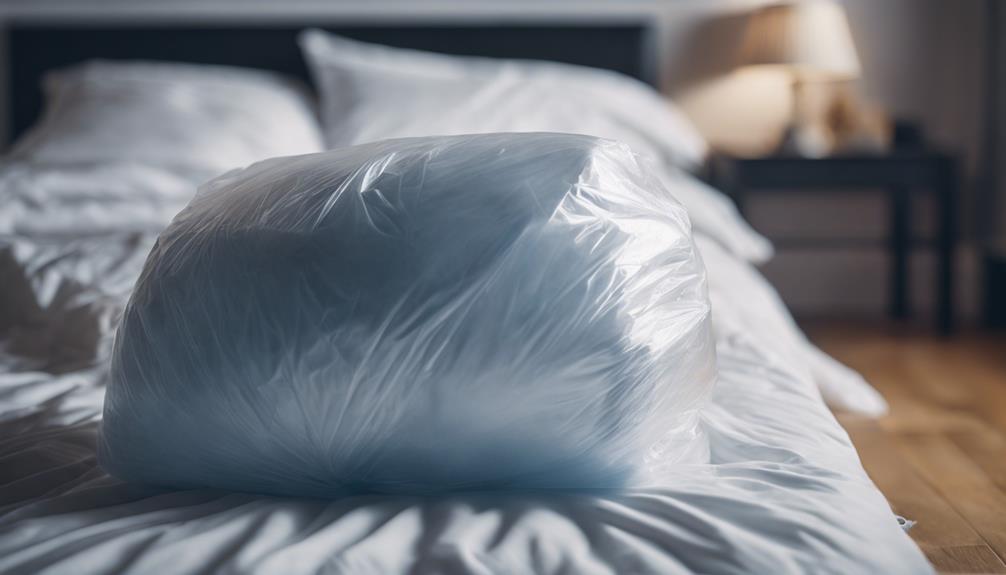Dogs may lick our comforter to find comfort and relaxation, seeking reassurance and affection. This behavior can signify bonding, love, and self-soothing tendencies. Dogs enjoy the scent and texture of comforters, strengthening their connection with us. Consistent licking may become habitual due to comfort and security needs or nesting instincts. Excessive licking may indicate stress or health issues, and veterinary consultation is essential. By observing licking patterns and seeking professional advice, we can better understand and address our dog’s needs. Veterinary assistance can help rule out underlying health concerns causing excessive licking. Understanding these behaviors can lead to a healthier relationship with our furry friends.
Key Takeaways
- Dogs lick comforters for comfort, security, and relaxation.
- Licking expresses affection, bonding, and a sense of well-being.
- Habitual licking behavior can stem from enjoyment, scent, and dental issues.
- Licking strengthens the bond with owners through scent.
- Excessive licking may signal stress, health issues, or allergies.
Reasons for Comforter Licking

We've observed that dogs engage in comforter licking for various reasons, including seeking comfort, security, and relaxation. When a dog licks your comforter, it may be a soothing behavior stemming from the texture and scent that provides them with a sense of calm and reassurance. The act of licking can also be a way for your dog to seek comfort and security by being close to your scent, which they find comforting and familiar.
Additionally, some dogs develop a habit of licking comforters due to the enjoyment they derive from this activity, much like how they may lick their bedding. This behavior can also be a sign of affection towards you, as dogs often exhibit licking as a form of bonding and showing love.
Furthermore, licking the comforter can be a method for dogs to self-soothe and relax, especially during stressful or anxious times. By understanding these reasons behind comforter licking, you can better cater to your dog's needs and provide suitable alternatives for redirecting this behavior.
Canine Comfort and Affection

Dogs often lick comforters as a way of bonding with their owners and seeking a cozy connection. This behavior allows them to express affection and feel close to their human companions, establishing a sense of comfort and security.
The scent and texture of the comforter can be soothing for dogs, reinforcing their instinctual need for warmth and closeness.
Licking as Bonding
When dogs lick comforters, it is often a heartfelt display of bonding and affection towards their human companions. This soothing behavior stems from a deep attachment and love they feel for you. Licking the comforter provides dogs with a sense of security, comfort, and closeness, reinforcing the bond through scent. As they engage in this calming act, they associate your scent with relaxation and safety, much like seeking warmth and comfort from their mother as puppies. The act of licking your comforter is not just a random behavior; it is a deliberate expression of their affection and desire to be close to you. Below is a table highlighting the key aspects of licking as a bonding behavior:
| Key Aspects | Description |
|---|---|
| Bonding | Demonstrates heartfelt connection |
| Affection | Shows love and attachment |
| Comfort | Provides a sense of security and comfort |
| Soothing Behavior | Calming act for dogs |
Seeking Cozy Connection
Seeking a cozy connection through licking, dogs express their affection and desire for closeness with their human companions.
- Dogs may view your comforter as a source of comfort and security, associating your scent with warmth and affection.
- Licking the comforter can be a soothing behavior for dogs, reminiscent of their puppyhood nursing instincts.
- The texture and warmth of the comforter may remind dogs of natural bedding, leading them to lick it as a comforting habit.
- Your dog licking the comforter is a way of expressing affection and seeking bonding and closeness with you. Understanding this behavior can help strengthen the connection between you and your furry friend.
Habitual Licking Behavior

When dogs exhibit habitual licking behavior, it can stem from their intrinsic need for comfort and security.
This behavior serves as a self-soothing mechanism, allowing dogs to cope with stress or anxiety.
The consistent scent and texture of your comforter may provide reassurance and familiarity, leading to repeated licking episodes.
Reasons for Licking?
Our canine companions may develop a habit of licking comforters for various reasons.
- Dogs may lick your comforter due to nesting instincts inherited from wild ancestors.
- Licking your comforter can be a way for your dog to seek comfort and security.
- Some dogs may lick your comforter as a soothing behavior, reminiscent of nursing from puppyhood.
- Health concerns like dental issues or allergies could also be reasons for your dog licking your comforter.
Impact on Comforter?
Constant licking by dogs can lead to staining and wear on comforters, potentially impacting their longevity. When dogs lick comforters, their saliva can contain enzymes and bacteria that may affect the fabric, causing staining and wear over time.
The constant moisture from licking can create a damp environment on the comforter, increasing the risk of mold and mildew growth. Certain fabrics may be more susceptible to damage from dog saliva, leading to quicker deterioration of the comforter.
To mitigate the impact of your dog's licking behavior, regular cleaning and maintenance of the comforter are essential. By staying on top of cleaning routines, you can help preserve the quality and lifespan of your comforter despite your dog's licking habits.
Scent Bonding With Owner

Engaging in scent bonding through licking comforters is a natural behavior for dogs to strengthen their connection with their owners and alleviate stress. Dogs often find comfort and security in the familiar scent of their owners, making the act of licking a calming mechanism that helps reduce stress and anxiety. By licking comforters, dogs are seeking affection and establishing a sense of security within their environment. This behavior not only helps them feel connected to their owners but also provides a source of emotional support in times of need.
- Scent bonding through licking helps dogs feel connected to their owners.
- Comforters retain the owner's scent, making them a comforting item for dogs to lick.
- Licking comforters is a natural way for dogs to seek affection and reduce stress.
- This behavior serves as a calming mechanism, similar to how puppies seek comfort from their mothers.
Addressing Excessive Licking

Excessive licking behavior in dogs can be indicative of various underlying factors such as stress, anxiety, or health issues. If your dog is excessively licking your comforter, it may be a sign that they're seeking comfort or experiencing heightened levels of stress or anxiety. Additionally, health issues like allergies, skin irritation, or gastrointestinal problems could also be causing this behavior.
To address excessive licking, consider providing alternative items for your dog to lick, such as safe toys or treats, to redirect their behavior in a positive way. Regular grooming and hygiene practices can also help reduce the need for your dog to excessively lick the comforter.
It's advisable to consult with a veterinarian or a pet behaviorist to receive tailored solutions to manage your dog's excessive licking behavior effectively. By addressing the root cause of the behavior, you can help your dog find healthier ways to cope with stress or discomfort.
Monitoring Licking Patterns

To effectively monitor your dog's licking patterns on comforters, observe and document their behavior regularly. By keeping a close eye on their actions, you can gain valuable insights into their licking behavior.
Here are some key points to keep in mind when monitoring your dog's licking patterns:
- Frequency and Duration: Note how often and for how long your dog licks the comforter.
- Triggers: Identify any specific triggers that may lead to increased licking behavior.
- Patterns: Look for any consistent patterns in when and where the licking occurs.
- Motivations: Consider whether the licking is driven by stress, boredom, or a desire for comfort.
Consulting With Veterinarian

Regularly consulting with a veterinarian can provide valuable insights into your dog's comforter licking behavior and help address any underlying health issues. Veterinarians are trained to assess your dog's overall well-being and can offer guidance on behavior modifications or medical treatments to tackle excessive licking behavior. By seeking veterinary help, you can receive personalized advice on how to discourage your dog's licking behavior effectively.
A professional evaluation by a veterinarian is important in ruling out potential allergies, skin irritations, or oral health problems that could be causing the behavior. Early intervention through veterinary help can prevent any escalation of health issues related to your dog's comforter licking behavior. Therefore, if you notice your dog engaging in excessive licking of your comforter, it's advisable to consult with a veterinarian promptly to prioritize your pet's health and well-being.
Health Issues and Allergies

Seasonal allergies can trigger dogs to lick comforters as a way to alleviate skin irritation or discomfort. When faced with allergies, dogs may resort to excessive licking of bedding, which can lead to red staining due to porphyrins present in saliva. This behavior is a sign of potential health issues that require veterinary consultation for proper diagnosis and treatment.
Addressing the underlying allergies causing discomfort is vital to prevent further skin irritation and excessive licking. By seeking professional veterinary advice, pet owners can make sure their dogs receive the necessary care and support to manage seasonal allergies effectively.
Remember that red staining on comforters isn't just a cosmetic issue but can indicate more profound health concerns that need attention. Stay vigilant and proactive in monitoring your dog's behavior and seek veterinary help promptly to safeguard their well-being.
Frequently Asked Questions
Why Does My Dog Lick My Bedding?
Dogs lick bedding for various reasons, such as seeking comfort, expressing affection, or out of enjoyment. This behavior can stem from their natural instincts or a need for security. Understanding why your dog licks bedding is important for managing it effectively.
Providing alternative items like toys or treats can help redirect this behavior. By addressing the root cause, you can promote healthier habits and guarantee your pet's well-being.
Why Does My Dog Keep Licking My Blankets?
Understanding the reasons behind why dogs continue to lick our blankets is crucial in addressing their behavior. By providing toys and attention, we can help redirect this behavior.
Observing your dog's actions and seeking guidance from a veterinarian if necessary are important steps. Remember, patience and empathy are key in addressing your furry friend's licking habits for their well-being.
Why Do Dogs Lick the Bed or Pillow?
Dogs may lick the bed or pillow as a comforting behavior, seeking security and familiarity. The scent and texture of these items can provide a sense of relaxation for them.
Licking may also be a way for dogs to show affection and bond with their owners. This habit can stem from puppyhood, associating the bed or pillow with warmth and comfort.
Persistent licking might indicate a need for attention, comfort, or a self-soothing mechanism.
How to Treat a Dog Obsessively Licking Fabric?
When treating a dog obsessively licking fabric, start by identifying potential causes like stress or boredom. Provide mental stimulation and appropriate chew toys to redirect the behavior.
Consult a vet to rule out medical issues and determine the best treatment plan. Behavioral changes, lifestyle adjustments, and possibly medication for OCD may be needed.
Monitor your dog closely and seek professional guidance for effective management and treatment of compulsive licking behaviors.
Is Licking Comforters a Sign of Dogs Marking Their Territory?
Some dog owners wonder if reasons dogs pee comforters include marking their territory. Licking comforters, however, is more likely a soothing behavior. Dogs may find comfort in the scent or texture of the fabric. If you notice excessive licking, it’s best to consult with a veterinarian.
Conclusion
To sum up, if your dog is licking your comforter, it could be due to a variety of reasons such as seeking comfort, showing affection, or simply out of habit.
It's important to monitor their licking patterns and consult with a veterinarian if necessary to rule out any underlying health issues or allergies.
By addressing this behavior early on, you can make sure your furry friend stays happy, healthy, and cozy without turning your comforter into a canine chew toy.










